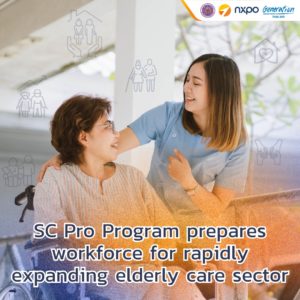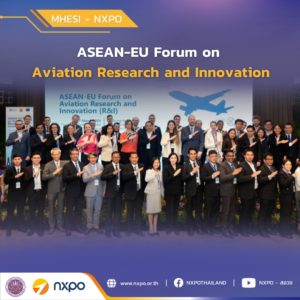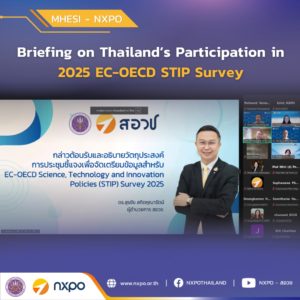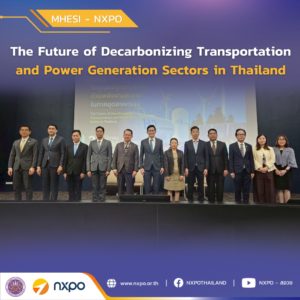On 6-7 August 2020, NXPO and King Mongkut’s University of Technology Thonburi (KMUTT) hosted a forum for young policy researchers to present their policy ideas, following their participation in the STI Policy Design Course Year 2 which started in February 2020. A joint effort between NXPO and KMUTT, the course aims at developing capacity of policy researchers, policy analysts and policy development specialists working in the STI (Science, Technology and Innovation) system in Thailand and supporting the network formation of people working on STI policy for future knowledge exchange and collaboration. The forum was attended by executives and experts in the Thai STI system, including Dr. Pichet Durongkaveroj, former Minister of Science and Technology and former Minister of Digital Economy and Society; Prof. Wichan Panich, Chairman of NXPO Advisory Board on Science, Research and Innovation Reform; Dr. Sakarindr Bhumiratana, former KMUTT President; Prof. Dr. Naksitte Coovattanachai, NXPO Advisor; Dr. Kitipong Promwong, NXPO President and CEOs of enterprises who serve as advisors to the course.

The presentations cover 9 areas as follows.
- Energy. As the global demand for energy is expected to double by 2050, the proposal focuses on strategy to strengthen Thailand’s energy security by increasing the use of renewable energy as well as boosting energy efficiency. Strategies proposed include the government to increase investment in manpower and infrastructure on renewable energy and energy efficiency research, as well as issue measures to incentivize the use of renewable energy in the public and private enterprises.
- Tourism. The study revealed a number of challenges faced by Thailand’s tourism industry. Due to COVID-19 pandemic, tourist numbers have dropped significantly. Even before COVID-19, tourists usually concentrate in a few big cities with insufficient plan and promotion of secondary cities, and tourist activities cause damages to the environment. The proposal made by the young policy researchers therefore focuses on collaboration among government agencies, academic institutes and local communities to create sustainable tourism with engagement of local communities to protect the environment and promote fair income distribution and benefit sharing to people in the communities.
- Poverty alleviation. Perpetual cycle of poverty is attributed to the lack of education and subsequently qualification for marginalized groups of people to have decent careers to earn a living. The proposal therefore focuses on utilizing higher education, science, research and innovation as a mechanism to provide education and create jobs.
- Electric vehicle (EV) industry. EV is the future trend of transportation and therefore the group proposes the government to design mechanisms to develop sufficient workforce for this booming industry through reskilling and upskilling program, as well as establishing a national center focusing on battery research.
- Higher education system. A concept of higher education institutes for community development was proposed, in order to produce quality human capitals, create innovations for businesses and industry located in the communities. This concept will require higher education system to be more flexible to facilitate the development of local economy as well as universities themselves and their staff.
- Tourism development through research. The proposal involves the inclusion of community-based tourism in the science, research and innovation strategic plan to effectively address the government policy to facilitate income distribution to local communities through tourism activities. In addition, the proportion of research fund allocated to research for primary cities and secondary cities should align with the national strategy on income distribution and sustainable development of local communities.
- Public-private partnership. Thai food industry has potential to compete in the global market. The country’s food export value ranked no. 12th in the world in 2018, whereas R&D expenditure of food industry ranked first among manufacturing industries in Thailand. The concept of public-private partnership in pilot plants for food industry is therefore proposed. The group further suggests that database on pilot plants and key features of each pilot plant should be developed and analyzed in order to design the national policy, budget allocation and law/regulations to support the establishment and operation of pilot plants.
- Agriculture. Among thhe challenges of Thai agriculture are climate change, intense competition in the world market and lack of interest in agriculture professions among young generations. The proposal “One community, One commodity, One tailored precision agriculture” involves the use of technology and innovation and university system to transform traditional agriculture into modern agriculture.
- Youth in the 21st century. As Thailand is entering an aging society, it is imperative that the country has a system set in place to address this issue by developing the new generations physically and mentally to be able to drive the economy and society effectively in the future. The strategy includes various aspects, including nutrition in school meals, digital education and strengthening small-sized schools, for instance.
President Kitipong commended young policy researchers for presenting interesting ideas which have potential to be developed into national policies. Participants of this STI Policy Design Course will have opportunities to present their work at the South East Asia Conference on STI Policy & Management 2020 to be hosted by Thailand later this year.













